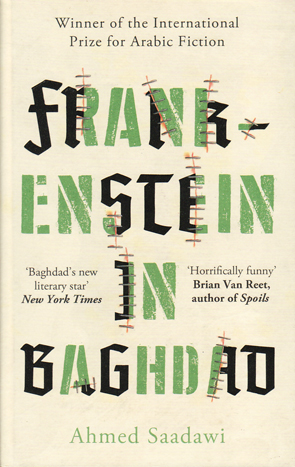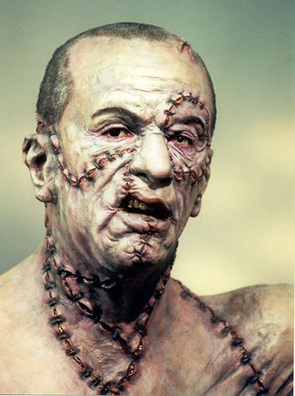It is Baghdad, 2003. Saddam Hussein has been captured and the American’s have a prominent presence in the city. The invasion is complete but in reality, the war continues. Baghdad is a city under siege. Bombings are routine, as are the corpses. Suddenly, there is a new figure on the scene: a man who hides his face; who, it is rumoured, cannot be killed by bullets; a man set upon killing the citizens of Iraq with his bare hands. This is the premise of Ahmed Saadawi’s novel, Frankenstein in Baghdad.
Winner of the International Prize for Arabic Fiction and shortlisted for the Man Booker International Prize, Saadawi’s novel is a grim, sometimes grotesque account of Baghdad after the fall of Hussein, and the impact of contemporary and historical forces on the Iraqi people.
Since its publication in 1818, Mary Shelley’s Frankenstein has been appropriated more times in film and novels than I could count. Ahmed Saadawi’s Frankenstein in Baghdad is the latest retelling I have come across. Saadawi’s version of the story has similarities to Czech, Indian and Latin-American writers who have used Magic Realist narratives for political ends. Saadawi tells of a corpse stitched together by a Baghdadi junk salesman, Hadi. His profession is appropriate since the cadaver parts he collects are the detritus of war, much like the furniture he buys and sells. Hadi’s motivation is difficult to explain, except that he has a sense of moral justice; he feels that the human remains he finds at bombing sites must be returned to a recognisably human figure so that the government might acknowledge their humanity and give them a burial. At least, that is what Hadi thinks he is doing. However, like his counterpart in Shelley’s novel, he is never really in control of his creation, and things take a turn. His stitched-together corpse is imbued with the spirit of a latest bombing victim, Hasib Mohamed Jaafar, a hotel guard who prevents the bombing of the hotel he protects but who dies while doing it. The corpse animates and goes on a murderous spree.
Hadi’s constructed corpse, like Shelley’s creature, never attains a fixed identity. It is known generally as Whatsitsname, as Daniel by Elishva after her dead son, as either the One Who Has No Name or tawabie al-khouf (familiar of fear) by the Tracking and Pursuit Department , as Criminal X by the media, sometimes as the creature
or monster
, recalling Shelley’s novel, as a Wahhabi (an ultra-conservative faction of Islam) or Shiite extremist in different parts of the city, as an agent of foreign powers by the Iraqi government, as an ingenious man set upon disrupting American objectives in Iraq by the Americans, and simply as Frankenstein by Mahmoud.
Mahmoud al-Sawadi is a young journalist infatuated with his boss’s lover, who becomes embroiled in the story of the corpse that kills people when he is introduced to Brigadier Sorour Mohamed Majid, the head of the mysterious Tracking and Pursuit Department, charged with arresting the murderer. Majid’s department has an unconventional approach, reminding me of Mulder in the X-Files, willing to believe outlandish theories, or Dale Cooper in Twin Peaks, with unusual modes operandi. Majid employs several astrologers and fortune-tellers, on high salary financed by the Iraqi treasury
in an effort to make predictions and head off insurgency. Their mission reminded me of the Precrime Unit from Minority Report.
In addition to this there is ordinary Iraqis like Elishva, an elderly Assyrian Christian who lives alone in Baghdad since her daughters have emigrated to Melbourne, Australia. Elishva cannot bring herself to leave Iraq since she clings to the deluded hope that her son, Daniel, who died in the Iran/Iraq war of the 1980s, will return home. The appearance of the corpse in her home eerily fulfils this hope.
Naturally, the historical context of the novel cannot be ignored when considering either its value or the purpose of Saadawi’s literary appropriation. Shelley’s original novel as adapted by Hollywood, especially in its early years, tended to focus on the spectacle of the creation in Frankenstein’s lab, even though this is glossed over in her novel. Shelley’s hints at her interest in galvanism were the inspiration for this. The creature in the early films tended to be a tormented animal reacting emotionally to its treatment. Later versions of the story, like Branagh’s version starring Robert de Niro, gave the creature intelligence but still focused upon its overweening desire for revenge and control. More recently there has been John Logan’s television series, Penny Dreadful with Rory Kinnear as the creature, far more in keeping with the heightened emotion and intelligence of Shelley’s original portrayal. Shelley’s creature, to my way of thinking, was a product of Romantic and Enlightenment thinking, and a reaction to industrialism. Shelley’s creature was a being fractured and dehumanised by industrialism, seeking its identity and struggling to reengage with its humanity. While Frankenstein was a modern Prometheus, as the novel’s subtitle suggests, his creature was a new Adam, estranged from God, his creator. When I read the novel I thought of the anonymous poor whose lives and values were being changed by the processes of industrialisation and modernity.
Saadawi’s appropriation works in similar ways. The creature (this is the term I decided upon while reading the novel) is stitched together by Hadi, not as a scientific experiment but as a moral reaction to the killing in Baghdad; as a reaction to war. It is a body constructed of disparate parts, signalling its disparate identity along with the deep disaffections in Baghdad and the Arabic world. But the creature’s own conception of its identity alludes to Baathist ideology. Like Saddam Hussein, who advocated a pan-Arabic identity in opposition to imperialist carving-up of the Middle East, the creature claims:
Because I’m made up of body parts of people from diverse backgrounds – ethnicities, tribes, races and social classes – I represent the impossible mix that never was achieved in the past. I’m the first true Iraqi citizen . . .
In the beginning the creature talks in moral absolutes, of victims and criminals that form its world, which furnish its need for self-justification in its program of revenge. I’m the only justice there is in this country
, it states. The purity of its ideological position is what allows the creature to claim a higher sense of identity, itself a representation of a modern Iraq free of clannish conflicts, despite its bastardised form. But its language is steeped in apocalyptic rhetoric with the potential for division:
I’m an instrument of mass destruction that presages the coming of the saviour that all the world’s religions have predicted. I’m the one who will annihilate people who have lost their way and gone astray.
The weakness in the creature’s ideology lies in its Manichean belief that the world is populated by either victims or criminals, which is the basis of his avenging mission. It is the meaning of his first true Iraqi citizen
, since his ideology tends towards absolutism and essentialism, which in turn echoes the Hussein’s pan-Arabic ideology. Yet these ideological positions are untenable. Each body part from which the creature is made – each essentially a victim or criminal in his mind – has its own history and identity, but they have all one thing in common: they exist as a part of the creature because their owner met their deaths violently. Each part of the creature is a victim and requires an individual revenge, even though the creature has predominantly killed those who have been perpetrators of crime. And as the creature enacts each revenge, his avenged pieces atrophy and fall from him, thereby necessitating an endless need for more victims and replacement parts; an endless cycle of violence and vengeance which shifts the creature along the moral spectrum towards essential criminality:
My list of people to seek revenge on grew longer as my old body parts fell off and my assistants added parts from my new victims, until one night I realised that under these circumstances I would face an open-ended list of targets that would never end.
It seems like a neat metaphor for the internecine conflicts that have plagued the Middle Eastern world. The creature’s language and motives shift as the flawed basis of his mission becomes apparent: I’m now taking revenge on people who insult me…
It’s a long step from the apocalyptic vision of righteousness and unity that first motivates him. In a moment of realisation the creature states : There are no innocents who are completely innocent or criminals who are completely criminal.
I think this is the power of Saadawi’s novel, that his appropriation is not merely a cosmetic reaction to the horror of war, but is able to subtly analyse the weaknesses of modes of thinking that perpetuate violence and conflict. The exercise of unrestricted power is essentially the abandonment of ideals, piecemeal. This may apply to American hegemony as it may to the regime of Saddam Hussein, whose Baathist party advocated a pan-Arabic agenda, much like the creature’s true Iraqi
ideal. The novel draws aspects of the character from Shelley’s novel – his intelligence and feeling, mixed with a sense of justice – and reimagines that successfully in this modern context.

 RSS Feed
RSS Feed Facebook
Facebook Instagram
Instagram YouTube
YouTube Subscribe to our Newsletter
Subscribe to our Newsletter




No one has commented yet. Be the first!